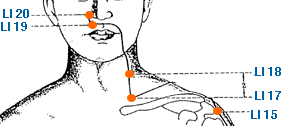LI 20
Acupuncture Point Theory
LI 20 Acupuncture Point Applications and Theory
 The acupuncture point "LI 20" , 迎香, is represented by "Ying Xiang" in pinyin and "Welcome Fragrance" in english and may be found:
The acupuncture point "LI 20" , 迎香, is represented by "Ying Xiang" in pinyin and "Welcome Fragrance" in english and may be found:
In the nasolabial groove, level with the midpoint of the lateral border of the ala nasi.
Of many possible clinical applications, it may be considered to influence the following issues/symptoms:
- Loss of smell or taste, nasal discharge, any nose a/or sinus issues, nasal polyps, rhinitis, sinusitis, allergies. Often combined with LI 19 and other local points.
- Tong Ren/Tam Healing System: Sinus issues, often combined with LI 17 and the huatuo of C3.
LI 20 has some precautions to be considered (see our precautions list).
Avoid Moxa (MX)
Li 20 has the following theoretical associations which serve as important guideposts in designing an effective treatment protocol:
- Exit Point
- Intersection point of the LI & ST Channels
Explore li 20 functional grouping theory - Entry Exit Point, or read all point categories and related theory.
A single acupuncture point is not commonly thought of as an empirical way to influence a TCM diagnostic pattern. LI20, however, is a strong candidate to be incorporated into an acupuncture protocol for patients who exhibit: Lung Qi Deficiency and/or Lung Wind Invasion - Wind Cold
LI 20 may potentially be used, in coordination with a well designed acupuncture treatment protocol, to influence the following conditions: Allergies, Nasal Polyps, Sinus Infection and/or Sinusitis
While not necessarily valid clinically, EX Bitong (Local point for nasal issues - obstruction, conge…), EX Biyan (Local point for nasal issues - obstruction, conge…), GV 25 ( Important point to restore or help maintain c…), GV 26 (One of two Command Points (with PC 6) added to th…), GV 27 ( Problems of the mouth and sinuses - tongue ul…), SI 18 (Local point for facial disorders, Bell's palsy, t…), ST 3 (Local point - Twitching eyelids, pain a/or swelli…) and ST 4 (Facial pain - Bell's palsy, facial paralysis, tri…) are nearby.
All Content 1999-2025
Chad J. Dupuis / Yin Yang House
Our Policies and Privacy Guidelines
Our Affiliated Clinics
